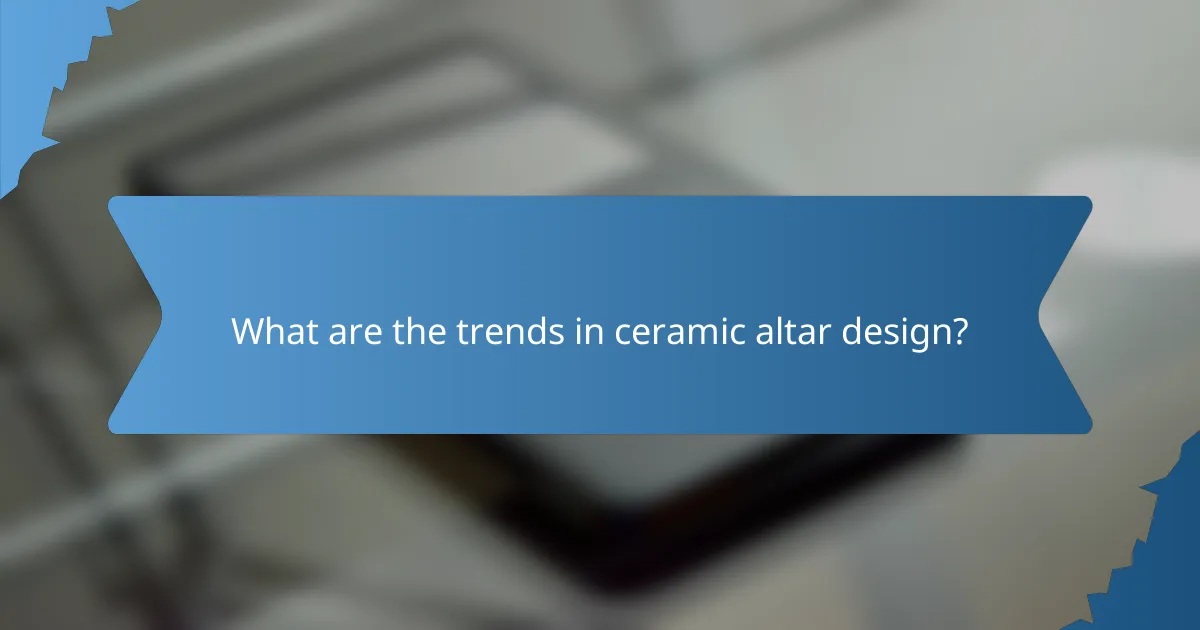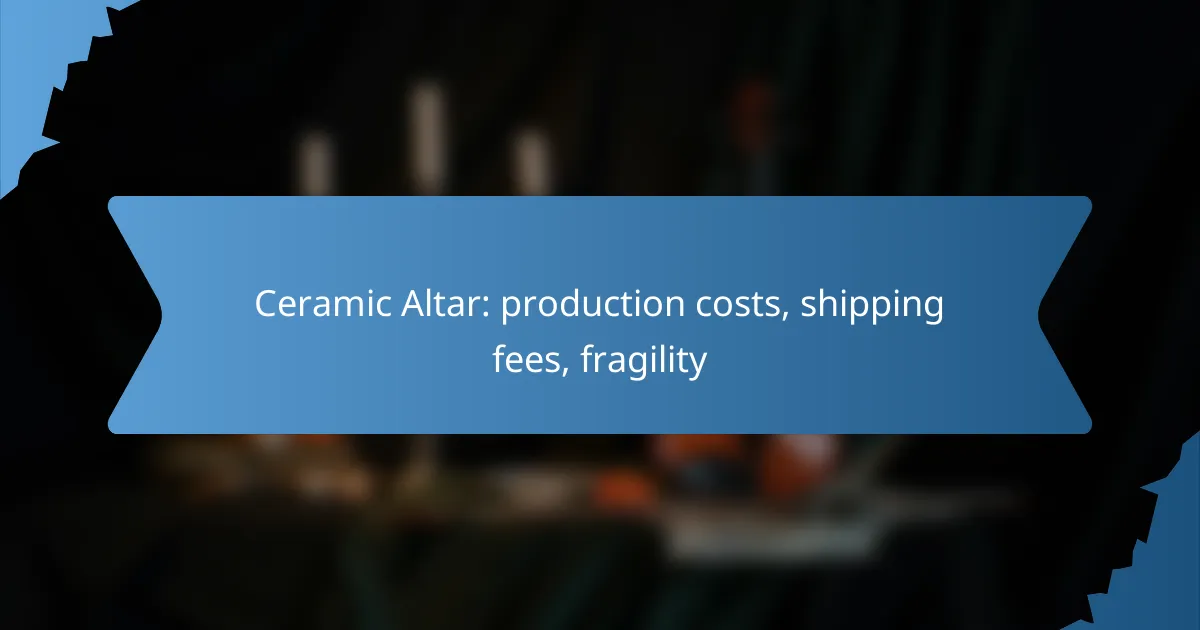Ceramic altars are intricate pieces that can vary widely in production costs, influenced by materials, labor, and design complexity. Shipping fees also play a crucial role, with costs typically ranging from $20 to $100 depending on size and weight. The fragility of these altars further affects pricing, necessitating specialized packaging and careful handling to ensure safe delivery.

What are the production costs of ceramic altars in the USA?
The production costs of ceramic altars in the USA can vary significantly based on several factors, including materials, labor, and design complexity. Generally, these costs can range from a few hundred to several thousand dollars, depending on the altar’s size and intricacy.
Material costs
Material costs for ceramic altars typically include clay, glazes, and any additional decorative elements. High-quality clay can range from $0.50 to $2.00 per pound, while specialized glazes may add another $0.10 to $1.00 per square foot. The choice of materials directly impacts the final product’s durability and aesthetic appeal.
For larger altars, bulk purchasing of materials can lead to cost savings. However, using premium materials can significantly increase overall expenses, so it’s essential to balance quality with budget constraints.
Labor expenses
Labor expenses for crafting ceramic altars can vary based on the skill level of the artisans and the complexity of the design. Skilled labor may cost between $20 to $50 per hour, depending on the region and experience. Intricate designs requiring more time will naturally lead to higher labor costs.
It’s crucial to account for both the initial crafting and any finishing work, such as glazing and firing, which requires additional labor hours. Efficient workflow and skilled artisans can help minimize these costs.
Equipment investment
Investing in equipment for ceramic altar production includes pottery wheels, kilns, and tools for shaping and finishing. A basic pottery wheel can cost around $300 to $1,000, while kilns may range from $1,000 to over $10,000, depending on size and features.
For small-scale production, renting equipment or sharing facilities can reduce upfront costs. However, owning high-quality equipment can enhance production efficiency and product quality in the long run.
Overhead costs
Overhead costs encompass utilities, rent, and maintenance associated with the production facility. These costs can vary widely based on location; for instance, urban areas typically have higher rent and utility rates compared to rural settings.
Estimating overhead as a percentage of total production costs is advisable, often falling between 10% to 30%. Keeping overhead low through efficient space utilization and energy-saving practices can improve overall profitability.
Cost variations by design
Cost variations by design are significant, as simpler designs generally incur lower production costs compared to elaborate, custom pieces. Basic altars may cost a few hundred dollars, while highly detailed or large-scale designs can exceed several thousand dollars.
When planning a design, consider both aesthetic goals and budget constraints. Collaborating with designers can help identify cost-effective solutions without sacrificing quality or visual appeal.

What are the shipping fees for ceramic altars in North America?
Shipping fees for ceramic altars in North America can vary widely based on factors such as size, weight, and shipping method. Generally, customers can expect to pay anywhere from $20 to $100 for standard shipping, with additional costs for expedited options.
Standard shipping rates
Standard shipping rates for ceramic altars typically range from $20 to $50 within the continental United States. This cost often depends on the altar’s weight and dimensions, as larger and heavier items incur higher fees. Many retailers offer flat-rate shipping, which can simplify budgeting.
For shipments to Canada, standard rates may be slightly higher, often falling between $30 and $70. It’s advisable to check with specific retailers for exact pricing, as some may provide free shipping on orders above a certain amount.
Expedited shipping options
Expedited shipping options for ceramic altars can significantly increase costs, generally ranging from $50 to $150. This service is ideal for customers needing faster delivery, often within 1 to 3 business days. However, the exact fee will depend on the shipping carrier and the delivery distance.
Some retailers may offer express options that guarantee delivery by a specific date, which can be beneficial for special occasions. Always confirm the estimated delivery time and associated costs before finalizing your order.
International shipping fees
International shipping fees for ceramic altars can vary greatly, often starting around $100 and potentially exceeding $300, depending on the destination country. Factors such as customs duties, taxes, and import regulations can also affect the total cost. It’s essential to research these fees beforehand to avoid unexpected charges.
Many retailers provide international shipping options, but not all will ship fragile items like ceramic altars. Check with the seller regarding their policies and any additional fees that may apply for international orders.
Insurance costs for fragile items
When shipping ceramic altars, purchasing insurance is highly recommended due to their fragility. Insurance costs typically add around 1% to 3% of the item’s value to the shipping fee. This investment can provide peace of mind, ensuring that you are compensated in case of damage during transit.
Some shipping carriers automatically include basic coverage, but this may not be sufficient for valuable items. Always verify the coverage limits and consider opting for additional insurance if the altar is particularly expensive or irreplaceable.

How does fragility affect ceramic altar pricing?
Fragility significantly impacts the pricing of ceramic altars due to increased production costs, specialized packaging needs, and higher shipping fees. Fragile items require more careful handling and additional resources to ensure they reach customers intact, which can elevate overall expenses.
Impact on production costs
The production costs of ceramic altars can rise due to the need for higher-quality materials and more meticulous craftsmanship. Fragile designs often require thicker walls or reinforced structures, which can lead to increased material costs. Additionally, skilled artisans may be needed to minimize defects, further driving up labor expenses.
Manufacturers may also choose to use more expensive glazes or firing techniques to enhance durability, which can add to the overall production cost. This means that consumers can expect to pay more for altars that prioritize both aesthetics and resilience.
Packaging requirements
Fragile ceramic altars necessitate specialized packaging to prevent damage during transit. This often includes custom foam inserts, double-boxing, or protective wrapping, all of which contribute to higher packaging costs. Standard packaging may not suffice, leading to additional expenses for both manufacturers and retailers.
Investing in quality packaging not only protects the product but also enhances customer satisfaction. Properly packaged items are less likely to be returned due to damage, which can save costs in the long run.
Shipping considerations
Shipping fragile ceramic altars can be more expensive due to the need for careful handling and insurance. Carriers often charge higher fees for items classified as fragile, and additional insurance may be necessary to cover potential damages during transit. This can significantly increase shipping costs compared to more durable products.
Choosing a reliable shipping provider that specializes in fragile items can mitigate risks but may come at a premium. It’s essential for businesses to factor these costs into their pricing strategy to maintain profitability.
Market demand for durable designs
There is a growing market demand for durable ceramic altar designs that can withstand handling and environmental factors. Consumers are increasingly looking for products that offer longevity and resilience, which can influence pricing strategies. Altars designed with durability in mind may command higher prices due to their perceived value.
Manufacturers that focus on creating robust designs can differentiate themselves in a competitive market. Offering warranties or guarantees on durability can also enhance consumer confidence and justify higher price points.

What are the best practices for transporting ceramic altars?
To effectively transport ceramic altars, it is crucial to use appropriate packaging, follow careful handling procedures, and select suitable transport methods. These practices help minimize the risk of damage during transit.
Recommended packaging materials
Using the right packaging materials is essential for protecting ceramic altars. Sturdy boxes made of double-walled cardboard provide a solid outer layer, while bubble wrap or foam padding can cushion the altar inside. Additionally, using packing peanuts can fill any voids in the box, preventing movement during transport.
Consider using moisture-resistant materials, especially if the altar will be shipped in humid conditions. This helps prevent any potential damage from moisture exposure.
Handling procedures
When handling ceramic altars, always lift them with care, using both hands to support the base and avoid putting pressure on delicate areas. It is advisable to wear gloves to prevent fingerprints and smudges on the surface.
Ensure that anyone involved in the handling process is trained in proper lifting techniques. Avoid stacking heavy items on top of the altars, as this can lead to cracking or breaking.
Transport methods
Choosing the right transport method is vital for the safe delivery of ceramic altars. Ground shipping is often preferred for domestic transport, as it allows for more controlled handling. For international shipping, air freight may be faster but can be more expensive.
Regardless of the method, ensure that the transport vehicle is equipped with proper climate control and cushioning to protect against vibrations and temperature fluctuations during transit.

What are the trends in ceramic altar design?
Current trends in ceramic altar design focus on a blend of traditional craftsmanship and modern aesthetics. Designers are increasingly incorporating unique styles and sustainable materials to appeal to contemporary spiritual practices.
Emerging styles
Emerging styles in ceramic altar design include minimalist, geometric shapes and vibrant, intricate patterns. These designs often reflect personal beliefs and cultural backgrounds, allowing for greater customization. For instance, some artisans are experimenting with asymmetrical forms that challenge conventional altar layouts.
Another trend is the use of mixed media, where ceramics are combined with other materials like wood or metal. This fusion creates visually striking pieces that stand out in both sacred and secular spaces. Additionally, the integration of lighting elements into ceramic altars is becoming popular, enhancing the overall ambiance.
Eco-friendly materials
Eco-friendly materials are gaining traction in ceramic altar production, as artisans seek to reduce their environmental impact. Many are opting for locally sourced clay and natural glazes that minimize harmful chemicals. This shift not only supports sustainable practices but also connects the altar to its geographical roots.
Recycled materials, such as reclaimed ceramics or glass, are also being used to create unique altar pieces. These materials can add character and history to the design while promoting sustainability. When selecting eco-friendly options, consider the durability and maintenance requirements to ensure longevity in use.
